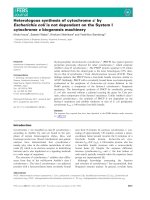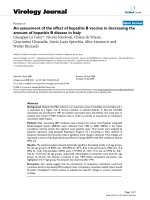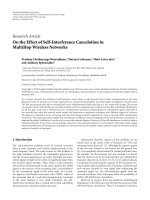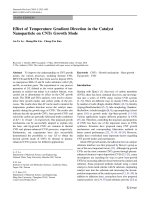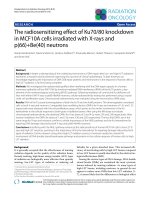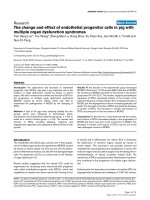Effect of different additions on the crystallization behavior and magnetic properties of magnetic glass–ceramic in the system Fe2O3–ZnO–CaO–SiO2
Bạn đang xem bản rút gọn của tài liệu. Xem và tải ngay bản đầy đủ của tài liệu tại đây (1.67 MB, 9 trang )
Journal of Advanced Research (2012) 3, 167–175
Cairo University
Journal of Advanced Research
ORIGINAL ARTICLE
Effect of different additions on the crystallization behavior
and magnetic properties of magnetic glass–ceramic in the
system Fe2O3–ZnO–CaO–SiO2
Salwa A.M. Abdel-Hameed
a
b
a,*
, Abeer M. El Kady
b
Glass Research Department, National Research Center, Dokki, ElBehoos St., Cairo 126222, Egypt
Biomaterial Department, National Research Center, Dokki, ElBehoos St., Cairo 126222, Egypt
Received 13 April 2011; revised 3 July 2011; accepted 3 July 2011
Available online 10 August 2011
KEYWORDS
Magnetite nanocrystals;
Glass–ceramic;
Ferrimagnetic;
Hyperthermia;
Cancer
Abstract This work pointed out the preparation of a magnetic glass–ceramic in the system Fe2O3ÆZnOÆCaOÆSiO2. The base composition was designed to crystallize about 60% magnetite. The influence
of adding TiO2, Na2O and P2O5 separately or as mixtures was studied. The DTA of the glasses revealed
a decrease in the thermal effects by adding P2O5, TiO2 and Na2O in an increasing order. The X-ray diffraction patterns showed the presence of nanometric magnetite crystals in a glassy matrix after cooling
from the melting temperature. The crystallization of magnetite increased by adding TiO2, and P2O5,
respectively, and decreased by adding Na2O. Heat treatment was carried out for the glasses in the temperature range of 1000–1050 °C, for different time periods, and led to the appearance of hematite and bwollastonite, which was slightly increased by adding P2O5 or TiO2 and greatly enhanced by adding
Na2O. Samples containing mixtures of TiO2, Na2O, and P2O5 showed a summation of the effects of
those oxides. The microstructure of the samples was examined by using TEM, which revealed a crystallite size of magnetite to be in the range of 52–90 nm. Magnetic hysteresis cycles were analyzed using a
vibrating sample magnetometer with a maximum applied field of 10 kOe at room temperature in
quasi-static conditions. From the obtained hysteresis loops, the saturation magnetization (Ms), remanence magnetization (Mr) and coercivity (Hc) were determined. The results showed that the prepared
magnetic glass–ceramics are expected to be useful for a localized treatment of cancer.
ª 2011 Cairo University. Production and hosting by Elsevier B.V. All rights reserved.
* Corresponding author. Tel.: +20 2 33371362x1325; fax: +20 2
33387803.
E-mail address: (S.A.M. Abdel-Hameed).
2090-1232 ª 2011 Cairo University. Production and hosting by
Elsevier B.V. All rights reserved.
Peer review under responsibility of Cairo University.
doi:10.1016/j.jare.2011.07.001
Production and hosting by Elsevier
Introduction
Nanoparticles ferrimagnetic glass–ceramics seem to play an
essential role in the future technology, especially in different
health care uses, such as cell separation, magnetic resonance
imaging contrast agents, drug delivery and hyperthermia treatment of cancer [1–4].
Hyperthermia destroys cancer cells, by raising the tumor
temperature to a ‘‘high fever’’ range, similar to the way that
the body naturally does to combat other forms of diseases
168
S.A.M. Abdel-Hameed, A.M. El Kady
[3]. Generally, tumors are more easily heated than the surrounding normal tissues. Blood vessels and nervous systems
are poorly developed in the tumor mass. Therefore, oxygen
supply that reaches the tumor via those vessels is not sufficient,
which leads to the death of cancer cells by heat treatment.
Hence hyperthermia is expected to be very useful in cancer
treatment. Moreover, hyperthermia has no side effects on the
healthy tissue that surround the tumor and has efficient blood
cooling systems [4,5].
The importance of magnetic nanoparticles or nanocrystals
comes from their remarkable new phenomena, such as superparamagnetism, high field irreversibility, high saturation field,
and extra anisotropy contributions or shifted loops after field
cooling. These phenomena arise from the finite size and surface
effects that dominate the magnetic behavior of individual
nanoparticles or nanocrystals [1,6,7].
In a previous work we have designed to precipitate $60%
nanocrystals of magnetite in two different compositions based
on the crystallization of hardystonite (Ca2ZnSi2O7), or wollastonite (CaSiO3), beside magnetite [4] and we have found that,
crystallization of magnetite nanocrystals was enhanced greatly
in the presence of Zn ions and consequently the saturation magnetization was enhanced and reached the value of 52.13 emu/g.
In the presented work, we have tried to improve the previously obtained magnetic properties [4]. This was carried out
through the investigation of the influence of the addition of
different oxides, such as TiO2, Na2O and P2O5, on the amount
and grain size of the precipitated magnetite nanocrystals in the
system Fe2O3ÆCaOÆZnOÆSiO2. These oxides were chosen because they were known to cause a decrease in the viscosity of
the melt, enhancing the phase separation process and consequently enhancing the crystallization process [8–14].
Material and methods
Preparation of glasses
Crystallization of glasses
Thermal behavior of our samples was examined using differential thermal analysis (DTA). DTA was performed using SETRAM Instrumentation Regulation, Labsysä TG-DSC16
under inert gas. According to the DTA results, the obtained
glasses were subjected to different heat treatment schedules.
This was carried out to study the effect of applying different
temperatures on their crystallization behavior. Samples plates
were covered with active carbon powder during the heat treatment, to apply a reducing atmosphere, and to prevent the ferrous ions from oxidizing while heating up the samples, at a rate
of 3 °C/min, up to various crystallization temperatures. Heating of samples was carried out in a SiC electric furnace. It was
noticed that the synthesis parameters (such as temperature,
time, heating rate, and atmosphere) play a fundamental role
for magnetite crystallization.
Characterization
The heat treated glasses were subjected to powder X-ray diffraction analysis (XRD), using Ni-filled Cu-Ka radiation, to determine the types and contents of the crystalline phases precipitated
as a result of their crystallization. XRD was performed using
Pruker D8 Advanced instrument. The average crystallite size
of magnetite, precipitated in the as prepared glasses, and of
those subjected to heat treatment, was determined for its most
intense peaks (220, 311, 400, 511 and 440), from their XRD patterns, by using Debye–Scherrer formula:
D ¼ kk=B cos H
The glass was designed to crystallize $60% magnetite and
40% hardystonite. The study of the effect of adding TiO2,
Na2O and P2O5 separately or as mixtures on the crystallization
sequence, and magnetic properties, was carried out. The samples were denoted as FHP, FHN, FHT and FHPNT according
to the oxide additions. The chemical compositions of the
examined glasses as well as their codes are shown in Table 1.
About 100 g powder mixtures of these compositions were prepared from the reagent grade of CaO (as Ca2CO3), SiO2,
Fe2O3, and ZnO. In addition, B2O3 (as H3BO3), TiO2, Na2O
(as Na2CO3) and P2O5 (as NH4H2PO4) were added above
100%. Our target was to obtain glass–ceramics, not ceramic
Table 1
materials, so a melting step was necessary to achieve the nucleation of magnetite in a liquid-derived amorphous phase. The
batches were placed in a platinum crucible, and melted in an
electric furnace, at 1350 °C for 2 h. The melts were poured
onto a stainless steel plate, at room temperature, and pressed
into a plate of 1–2 mm thick by another cold steel plate.
where D is the particle size, k is constant, k for Cu is 1.54 A˚, B
is the full half wide and 2H = 4°. The heat treated glasses were
crushed, and sonically suspended in ethanol. Few drops of the
suspended solution were placed on an amorphous carbon film
held by copper microgrid mesh and were observed under transmission electron microscope (ZEISS Germany).
The magnetic properties of the as prepared and heat treated
samples were measured at room temperature using a vibrating
sample magnetometer (VSM; 9600-1 LDJ, USA) in a maximum applied field of 10 kOe. From the obtained hysteresis
loops, the saturation magnetization (Ms), remanence magnetization (Mr) and coercivity (Hc) were determined.
Chemical composition of the studied glasses in wt.%.a
Sample
Fe2O3
CaO
ZnO
SiO2
B2O3
P2O5
Na2O
TiO2
FH
FHP
FHN
FHT
FHPNT
60
60
60
60
60
14.3
14.3
14.3
14.3
14.3
10.38
10.38
10.38
10.38
10.38
15.32
15.32
15.32
15.32
15.32
3
3
3
3
3
–
3
–
–
3
–
–
3
–
3
–
–
–
3
3
a
B2O3, P2O5, Na2O and TiO2 were added above 100%.
Crystallization of magnetic glass–ceramics
169
Results and discussion
Table 2
The compositions of all glasses were not significantly different.
Therefore, the observed thermo-physical properties of all the
glasses were similar with respect to their Tg, Tc, and lH values.
However, it was clear that any slight changes in their composition, by the introduction of nucleating agents, may have dramatic effects on the chronology and morphology of the
precipitated phases [15]. Fig. 1 and Table 2 reveal the thermal
behavior of the samples under investigation. All the samples
showed transformation temperatures in the range of 587–
662 °C, and one exothermic peak in the range of 788–840 °C.
It could be noticed that the temperatures of the thermal effects
increased by adding P2O5 (FHP) than that of the base glass
(FH), while the addition of Na2O led to a significant decrease
in all the temperatures of the thermal effects. The addition of
TiO2 (FHT) showed thermal effects similar to that of the base
glass. The addition of mixtures of P2O5, TiO2 and Na2O
(FHPNT) led to slight shifts in Tg and exothermic peaks to
lower temperatures. This effect was due to the summation of
the individual oxide effects. It should be noted that the increase in all the exothermic and endothermic peaks indicates
an increase in the amount of magnetite phase precipitated in
the quenched glass and led to observed thermal transformation
processes that occurred at higher temperatures, and the opposite is right [2]. Furthermore, the peaks of FHN had larger
areas and, consequently, had higher enthalpy than those re-
Fig. 1
DSC results of samples under investigation.
Sample
Tg (°C)
Exothermic peak (°C) Enthalpy (lV s/mg)
FH
FHP
FHN
FHT
FHPNT
662
683
587
662
639
838
840
788
831
830
À10.4299
À3.7129
À15.3775
À12.0901
À11.3595
corded for FHT, FHPNT and FHP, respectively. This can
be attributed to the fact that the addition of P2O5 greatly enhances the precipitation of the magnetite in glass melts during
their cooling from the melting temperatures, while the addition
of Na2O had a significant effect on inhibiting magnetite formation during cooling. On the other hand, the addition of TiO2
had increased the amount of crystallized magnetite; however,
its effect was slightly lower than that caused by the addition
of P2O5. All curves showed a glass transition temperature
(Tg) typical of an amorphous phase. The Tg values of glass–
ceramics are useful as an indicator of the amount of SiO2 in
the residual glass [11]. The presence of the glass transition temperature confirmed the presence of a reasonable amount of
residual amorphous phases in all the glass–ceramic samples.
As the amount of magnetite in the quenched glass was increased, the Tg was increased. The glass transition temperatures of the prepared glass–ceramics were similar to those of
DTA curves of samples under investigation.
170
the glasses containing iron ions [16,17], this was clearly noticed
for FHPNT sample (639 °C).
The X-ray diffraction patterns of the as prepared samples
after cooling from the melting temperature are shown in
Fig. 2(a). The picture presents the patterns corresponding to
the common structure of magnetite (Fe3O4). The diffraction
lines of the crystallized magnetite are slightly shifted, as compared with the reference data, indicating a slight variation of
the lattice constants of magnetite.
By comparing the XRD pattern of the base sample [4] with
those obtained for the samples, after the addition of P2O5,
Na2O and TiO2 (Fig. 2 and Table 3), we could notice that, in gen-
S.A.M. Abdel-Hameed, A.M. El Kady
Table 3 Crystallized phases at different heat treatment
schedules.
Sample
Heat treatment
parameters
Crystallized phases
FHP
As quenched
1000 °C/1 h
1050 °C/1 h
1050 °C/3 h
Magnetite
Magnetite, hematite, b-wollastonite
Magnetite, hematite, b-wollastonite,
cristobalite
Magnetite, hematite
FHT
As quenched
1000 °C/1 h
1050 °C/1 h
1050 °C/3 h
Magnetite
Magnetite, hematite, b-wollastonite
Magnetite, hematite, b-wollastonite
Magnetite, hematite
FHN
As quenched
1000 °C/1 h
1050 °C/1 h
1050 °C/3 h
Magnetite
Magnetite, hematite, b-wollastonite
Magnetite, hematite, b-wollastonite
Magnetite, hematite, b-wollastonite
FHPNT
As quenched
1000 °C/1 h
1050 °C/1 h
1050 °C/3 h
Magnetite,
Magnetite,
Magnetite,
Magnetite,
hematite
hematite, b-wollastonite
hematite, b-wollastonite
hematite, b-wollastonite
eral, the amounts of magnetite that crystallizes directly by cooling down the samples from melting temperature were slightly
smaller than those precipitated in base glass FH. Adding P2O5
(FHP) revealed the crystallization of large amounts of only magnetite phase (slightly lower than base composition). Significant
decreases in the amounts of magnetite were detected by adding
TiO2 and Na2O, respectively. Addition of mixtures of P2O5,
Na2O and TiO2 led to the crystallization of a larger amount of
magnetite than that precipitated in FHN and FHT; but still lower than that precipitated in FHP. Traces of hematite appeared in
quenched FHPNT samples. It could be clearly seen that all
glass–ceramic samples have a high degree of crystallinity, as revealed by sharp peaks. The broadness of the peaks were in the
order of FHT > FHN > FHPNT > FHP and consequently
the crystallite size was increased in the order of FHT < FHN <
FHPNT < FHP (Table 4). The difference in the relative
amount of crystallized magnetite in the samples (in spite of that
all samples contained the same amount of iron oxide) could be
attributed to the different effects of the added oxides on viscosity, phase separation, and the formation of solid solution with
magnetite and consequently some iron oxides remain entrapped
in the matrix [18].
Heat treatments of the samples at different temperatures
revealed the crystallization of hematite, and b-wollastonite as
minor phases, beside the main crystallized phase of magnetite.
Traces of cristobalite appear in FHP sample that was heat
treated at 1050 °C/1 h. The amounts of minor crystallized
phases depended on the chemical composition and heat
treatment schedules. The relative crystallization of hematite
and b-wollastonite, with respect to magnetite, was very small
Table 4
samples.
Fig. 2 XRD analysis of FHP, FHN, FHT and FHPNT samples,
(a) without heat treatment, (b) heat treated at 1000 °C/1 h, (c) heat
treated at 1050 °C/1 h and heat treated at 1050 °C/3 h.
Crystallite size of magnetite (nm) for different
Sample
FHN
FHT
FHP
FHPNT
As quenched
1000 °C/1 h
1050 °C/3 h
71.86
69.5
69
67
87.8
60.16
90
54
56.37
79.3
70.5
52
Crystallization of magnetic glass–ceramics
171
in sample FHP after it was subjected to different heat treatment schedules, while, those phases were largely developed in
samples FHPNT, FHT and FHN, respectively (Fig. 2).
Crystallite size obtained from XRD (Fig. 3a and Table 4)
showed, in general, the crystallization of nanocrystals of magnetite (<100 nm). The crystallite size of magnetite in the as
quenched samples is relatively increased by adding P2O5 and
decreased by adding TiO2. By applying heat treatments, the
crystallite size was noticed to decrease greatly in the FHP
and FHPNT, while it slightly decreased in the FHT and FHN.
The lattice constants of magnetite (Fig. 3b) revealed an increase in the lattice constants of all the prepared samples than
that sited in JCPDS (Joint Committee on Powder Diffraction
Standards) cards (a0 = 8.393–8.399 A˚). The effect of different
additions on the lattice constants were found to increase in the
order of TiO2 < P2O5 < Na2O. The lattice strain had an
opposite direction to lattice constants, so the lattice strain
was increased in the order of TiO2 > P2O5. Increasing the lattice strain led to an increase in the internal forces/stresses
which could oppose the crystal growth of magnetite. Consequently, the crystallite size of magnetite, in the case of FHT
sample, was slightly lower than that in FHP. By applying heat
treatment at different temperatures, the lattice constants were
found to increase. Increasing the lattice constant than that cited in JCPDS could be attributed to the incorporation of different cations in a solid solution with magnetite. EDXA (Fig. 4
and Table 5) showed the incorporation of Zn, Ca, and Si in a
solid solution with magnetite. It was noticed that the atomic
ratio of the incorporated Zn ions in magnetite is quite constant
$5.2Fe:1Zn, mapping of atoms (Fig. 4) detected the presence
of Zn atoms adhering to Fe atoms.
TEM of different samples are shown in Fig. 5. The crystallization of one or different phases was evident in TEM micro-
Crystlite size (nm)
100
FHN
FHT
FHP
FHPNT
80
60
40
20
0
As quenched
1000°C/1h
1050°C/3hs
Fig. 3a Crystallite size of different samples at different heat
treatment schedules.
Fig. 3b Variation of lattice constant of magnetite nanocrystals
with composition and heat treatment, (a) lattice constant of
magnetite from JCPDS cards, (b) lattice constant of magnetite in
quenched glass and (c) in glass heat treated at 1050 °C/1 h.
graphs. TEM revealed the precipitation of nanosize rounded
crystals of magnetite in the quenched FHP. The crystallite size
was decreased by the heat treatment at 1050 °C/3 h, as seen before from XRD analysis. The heat treated FHT showed uniform crystallization of needle like crystals of magnetite.
Quenched FHN showed the precipitation of different crystallite shapes of relatively larger sizes, which were dispersed between the small magnetite crystals and coagulation of hay
like crystals of hematite appeared, while the heat treated sample revealed uniform crystallization of nanosize crystals.
FHPNT heat treated at 1050 °C/3 h revealed uniform distribution of unique rounded nanocrystals of magnetite.
Effects of different additions on the specific magnetization
(Ms), remanence (Mr) and coercivity (Hc) of the prepared samples were measured at room temperature in a maximum field of
10 kOe and are summarized in Table 6, while the hysteresis
measurements are shown in Fig. 6. It could be observed that
all the samples exhibited a similar magnetic behavior, which
is characteristic for soft magnetic materials, with a thin hysteresis cycle and low coercive field (<24 Oe for quenched samples
and <74 Oe for heat treated samples). Magnetic properties
were strongly dependent on the added oxides. Saturation magnetization was increased by adding TiO2 (56.49 emu/g), and
P2O5 (58.99 emu/g), while being decreased by adding Na2O
in the quenched samples. Addition of mixtures of oxides in
FHPNT also revealed a high saturation magnetization
$56.7 emu/g. The coercive field was decreased from 24.76 for
FHP and 22.1 for FHT to 19.75 Oe for FHPNT.
Bretcanu et al. [2] measured the saturation magnetization of
magnetite particles around 74 emu/g, and the coercive force
was 150 Oe, which was lower than the reported data due to
the powder form of the sample. They explained this behavior
as follows, as the surface/volume ratio was increased, the saturation magnetization was decreased. They calculated the
amount of crystallized magnetite from the linear relationship
between the saturation magnetization and the content of the
magnetite. Therefore, the quantity of magnetite crystallized
in the glass–ceramics could be calculated from the ratio of saturation magnetization between the samples and magnetite.
The estimated amounts of magnetite crystallized (Table 6)
were $80 wt.% in the FHP, $76% in FHT and $77% in
FHPNT. Those values are in agreement with the ones estimated by the XRD data. Those values are much higher than
the amount of iron oxide added $60%. This could be attributed to the incorporation of the different cations in magnetite
as solid solution. The difference in the amount of magnetite
crystallized was matched with the effect of the addition of different oxides in the enhancement of the crystallization of magnetite as cited before. Magnetization increased with the
amount of magnetite crystallized in the samples. Glass–ceramic containing higher quantity of magnetite revealed a higher
value of saturation magnetization.
The remanence detected is the amount of magnetic materials which could be magnetized, even in the absence of external
magnetic field. The remanence magnetization values were
much lower than the saturation magnetization values. This
could be due to structural features of glass–ceramic [2]. The
coercive field depends on the microstructure. In general, as
the particle size was increased, the coercive field was decreased.
Heat treatment at 1050 °C/3 h led to a significant decrease
in the saturation magnetization ($1, 16 and 44 emu/g for
FHN, FHT and FHP, respectively) and to an increase in the
172
S.A.M. Abdel-Hameed, A.M. El Kady
Fig. 4
EDAX of FH sample heat treated at 1000 °C/1 h with mapping pictures.
Table 5 The atomic and weight % of different elements in FH
sample heat treated at 1000 °C/1 h by EDAX technique.
Element
Weight %
Atomic %
OK
Si K
Ca K
Fe K
Zn K
39.42
7.20
8.54
36.61
8.23
66.33
6.90
5.73
17.65
3.39
Total
100
100
coercivity ($75, 19 and 22 Oe for FHN, FHT and FHP,
respectively) which was attributed to magnetic nanocrystalline
anisotropy.
Role of P2O5
It has been reported that P2O5 increases the nucleation density,
which restricts the crystal growth, and induces an amorphous
phase separation [18]. P2O5 could induce the phase separation
to promote a heterogeneous nucleation and then produce a
fine-grained interlocking morphology. The heterogeneous
nucleation was favorable to reduce the nucleation energy.
The addition of P2O5, greatly affects phase formation and
morphology. It led to a slight increase in the peak crystallization temperature observed in DTA curves due to the reduction
in the number of remaining sites available for magnetite crystallization, where most of the magnetite was crystallized from
melt during cooling to room temperature.
Weinberg and co-workers [19] suggested that the nucleation agents could be selectively enriched in one separated
phase, thus providing the cites for nucleus. Ryerson [20] proposed that when a modifier cation was added in a silica melt,
it was surrounded by both bridging oxygen (Ob) and non
bridging oxygen atoms (Onb). The Onb isolates the network-modifier cations from each other by providing screens
that mask their positive charge. However, modifier cations
that are partly or wholly coordinated by bridging oxygen
are poorly shielded from each other. Consequently, substantial columbic repulsions occur between network-modifier cat-
Crystallization of magnetic glass–ceramics
Fig. 5
173
TEM of different samples after cooling from the melting temperature.
ions which give rise to the enthalpy of unmixing and
consequently lead to phase separation [21]. Merzbacher and
White found that the immiscibility fields expand with a decrease in the ionic radius of the modifier cation in binary
silicate melt [22].
Role of TiO2
In addition, TiO2 was reported to induce a phase separation in
many compositions [11] by Ti4+ ions attracting the non
bridged oxygen atoms to the bound arise of bridged domains.
174
Table 6
S.A.M. Abdel-Hameed, A.M. El Kady
Magnetic properties obtained under a maximum magnetic field of 10 kOe.
Sample No.
FHT
FHT
FHP
FHP
FHN
FHPNT
Heat treatment
Quenched
1050 °C/3 h
Quenched
1050 °C/3 h
1050 °C/3 h
Quenched
Magnetite quantity (wt.%)
76
22
80
60
1.39
77
Magnetic properties
Ms (emu/g)
Mr (emu/g)
Mr/Ms
Hc (Oe)
56.49
16.01
58.99
44.31
1.028
56.71
4.592
1.202
4.634
3.199
0.1864
4.129
0.0812
0.0750
0.0785
0.0723
0.1813
0.0728
22.1
19.37
24.76
22
74.85
19.75
However, for the formed domains to be stable, each Ti4+ must
possess no more than two non-bridged oxygen atoms [23]. In
the present composition, the number of non-bridged oxygen
atoms is far in excess of 2. Thus, it is likely that Ti4+ could
loosen from the network and crystallize separately in the form
of TiO2 or titanate phases. This would leave P2O5 alone to induce the phase separation [24]. This may happen when we mix
TiO2 with P2O5 in FHPNT.
It was proposed that, the immiscibility arises, because the
melts were composed of network-former as well as networkmodifier cations. Those modifier cations compete to form a
non-bridging oxygen, in order to properly balance the charge.
The greater the possibility for those network-modifiers to be
surrounded by a non-bridging oxygen, the greater is the tendency to immiscibility [14].
The incorporation of a small amount of TiO2 had an influence on the thermal and stability parameters of the phases
crystallized at a given heating rate. The temperature difference
Tc À Tg was used as an indication of the thermal stability of
glasses. The higher the value of this difference, the more the
delay in the nucleation process and hence more stable glass
was prepared [25].
Role of Na2O
The crystallization process of the glass during the reheating
process was known to be connected with the nature and proportions of its oxide constituents. The ability of some cations
to build glass forming units or to be housed as modifiers in
interstitial positions in the glass structure should also be considered [26]. Sodium oxide is a good glass modifier and has a
beneficial effect in lowering the temperature that is used to
convert the glass into a glass–ceramic. It could be housed in
the glass structure in the interstices positions which increase
the number of non bridging oxygen groups between the
(SiO4) chains, i.e. decrease the stability of the SiO4 chain
[27,28]. This could be attributed to the gradual decrease of viscosity due to the addition of Na+.
Conclusions
Fig. 6 Effect of different additions and heat treatment on the
hysteresis loop.
Magnetic glass–ceramic in the system Fe2O3ÆZnOÆCaOÆSiO2
was prepared. The base composition was designed to crystallize about 60% magnetite. The influence of adding TiO2,
Na2O and P2O5 separately or as mixtures was studied. The
DTA of the glasses revealed a decrease in the thermal effects
by adding P2O5, TiO2 and Na2O in an increasing order. The
X-ray diffraction patterns showed the presence of nanometric
magnetite crystals in a glassy matrix after cooling from the
melting temperature. The crystallization of magnetite increased by adding TiO2, P2O5, respectively, and decreased by
Crystallization of magnetic glass–ceramics
adding Na2O. Heat treatment in the temperature range of
1000–1050 °C for different time periods led to the appearance
of hematite and b-wollastonite which was slightly increased by
adding P2O5 or TiO2 and greatly enhanced by adding Na2O.
Samples containing mixtures of TiO2, Na2O, and P2O5 showed
a summation of the effects of these oxides. The microstructure
was studied using TEM which revealed a crystallite size in the
range of 52–90 nm. From the obtained hysteresis loops, the
saturation magnetization (Ms), remanence magnetization
(Mr) and coercivity (Hc) were determined. The results showed
that these materials are expected to be useful for localized
treatment of cancer.
Acknowledgment
This project was supported financially by the Science and
Technology Development Fund (STDF), Egypt, Grant No.
1044.
References
[1] Tartaj P, Del Puerto Morales M, Veintemillas Verdaguer S,
Gonza´lez Carre~
no T, Serna CJ. The preparation of magnetic
nanoparticles for applications in biomedicine. J Phys D: Appl
Phys 2003;36(13):R182–97.
[2] Bretcanu O, Spriano S, Verne´ E, Co¨isson M, Tiberto P, Allia P.
The influence of crystallised Fe3O4 on the magnetic properties of
coprecipitation-derived ferrimagnetic glass–ceramics. Acta
Biomater. 2005;1(4):421–9.
[3] Bretcanu O, Verne´ E, Co¨isson M, Tiberto P, Allia P.
Temperature effect on the magnetic properties of the
coprecipitation derived ferrimagnetic glass–ceramics. J Magn
Magn Mater 2006;300(2):412–7.
[4] Abdel-Hameed SAM, Hessien MM, Azooz MA. Preparation
and characterization of some ferromagnetic glass–ceramics
contains high quantity of magnetite. Ceram Int 2009;35(4):
1539–44.
[5] Ebisawa Y, Miyaji F, Kokubo T, Ohura K, Nakamura T.
Bioactivity of ferrimagnetic glass–ceramics in the system FeO–
Fe2O3–CaO–SiO2. Biomaterials 1997;18(19):1277–84.
[6] Hessien MM, Rashad MM, El-Barawy K, Ibrahim IA. Influence
of manganese substitution and annealing temperature on the
formation, microstructure and magnetic properties of Mn-Zn
ferrites. J Magnet Magnet Mater 2008;320(9):1615–21.
[7] Schadewald U, Halbedel B, Romanus H, Hulsenberg D. New
results of the crystallization behavior of hexagonal barium
ferrites from a glassy matrix. Mat-wiss Werkstofftech
2006;37(11):941–4.
[8] Alizadeh P, Marghussian VK. Effect of nucleating agents on the
crystallization behaviour and microstructure of SiO2–CaO–MgO
(Na2O) glass–ceramics. J Eur Ceram Soc 2000;20(6):775–82.
[9] Mirsaneh M, Reaney IM, Hatton PV, Bhakta S, James PF. Effect
of P2O5 on the early stage crystallization of K-fluorrichterite
glass–ceramics. J Non-Cryst Solids 2008;354(28):3362–8.
[10] Zheng X, Wen G, Song L, Huang XX. Effects of P2O5 and heat
treatment on crystallization and microstructure in lithium
disilicate glass–ceramics. Acta Mater 2008;56(3):549–58.
175
[11] Arvind A, Sarkar A, Shrikhande VK, Tyagi AK, Kothiyal GP.
The effect of TiO2 addition on the crystallization and phase
formation in lithium aluminum silicate (LAS) glasses nucleated
by P2O5. J Phys Chem Solids 2008;69(11):2622–7.
[12] Hu AM, Li M, Mao DL. Growth behavior, morphology and
properties of lithium aluminosilicate glass–ceramics with
different amount of CaO, MgO and TiO2 additive. Ceram Int
2008;34(6):1393–7.
[13] Rezvani M, Eftekhari Yekta B, Solati Hashjin M, Marghussian
VK. Effect of Cr2O3, Fe2O3, and TiO2 nucleants on the
crystallization behavior of SiO2–Al2O3–CaO–MgO–(R2O)
glass–ceramics. Ceram Int 2005;31(1):75–80.
[14] Mingsheng MA, Wen NI, Yali W, Zhongjie W, Fengmei LIU.
The effect of TiO2 on phase separation and crystallization of
glass–ceramics in CaO–MgO–Al2O3 –SiO2 –Na2O system. J
Non-Crystal Solids 2008;354(52–54):5395–401.
[15] Khater GA, Idris MH. Role of TiO2 and ZrO2 on the
crystallizing phases and microstructure in Li, Ba
aluminosilicate glass. Ceram Int 2007;33(2):233–8.
[16] Karamanov A, Pelino M. Crystallization phenomena in ironrich glasses. J Non-Cryst Solids 2001;281(1–3):139–51.
[17] Arcos D, Del Real RP, Vallet Regı´ M. Biphasic materials for
bone grafting and hyperthermia treatment of cancer. J Biomed
Mater Res A 2003;65(1):71–8.
[18] Wen G, Zheng X, Song L. Effects of P2O5 and sintering
temperature on microstructure and mechanical properties of
lithium disilicate glass–ceramics. Acta Mater 2007;55(10):
3583–91.
[19] Weinberg MC, Neilson GF, Uhlmann DR. Homogeneous
versus heterogeneous crystal nucleation in Li2OÆ2SiO2 glass. J
Non-Cryst Solids 1984;68(1):115–22.
[20] Ryerson FJ, Hess PC. The role of P2O5 in silicate melts. Geochm
Cosmechim Acta 1980;44(4):611–24.
[21] Agarwal A, Tomozawa M. Determination of fictive temperature
of soda-lime silicate glass. J Am Ceram Soc 1995;78(3):827–9.
[22] Merzbacher CI, White WB. The structure of alkaline earth
aluminosilicate glasses as determined by vibrational
spectroscopy. J Non-Cryst Solids 1991;130(1):18–34.
[23] Barry TI, Clinton D, Lay LA, Mercer RA, Miller RP. The
crystallization of glasses based on eutectic compositions in the
system Li2O–Al2O3–SiO2. Part I: Lithium metasilicate-bspodumene. J Mater Sci 1969;4(7):596–612.
[24] Barry TI, Clinton D, Lay LA, Mercer RA, Miller RP. The
crystallization of glasses based on the eutectic compositions in
the system Li2O–Al2O3–SiO2. Part II: Lithium metasilicate-beucrypite. J Mater Sci 1970;5(2):117–26.
[25] Park J, Ozturk A. Effect of TiO2 addition on the crystallization
and tribological properties of MgO–CaO–SiO2–P2O5–F glasses.
Thermochim Acta 2008;470(1–2):60–6.
[26] Park YJ, Bary PJ. Determination of the structure of glasses in
the manganese borate (MnO–B2O3) system using 11B NMR. J
Korean Phys Soc 1981;14(1):67–74.
[27] Scholze H. Glass: nature, structure and properties. NY:
Springer-Verlag; 1990.
[28] Deer WA, Howie RA, Zussman J. An introduction to the rock
forming minerals. Hong Kong: Third ELBS impression,
Common Wealth, Printing Press Ltd.; 1992.
